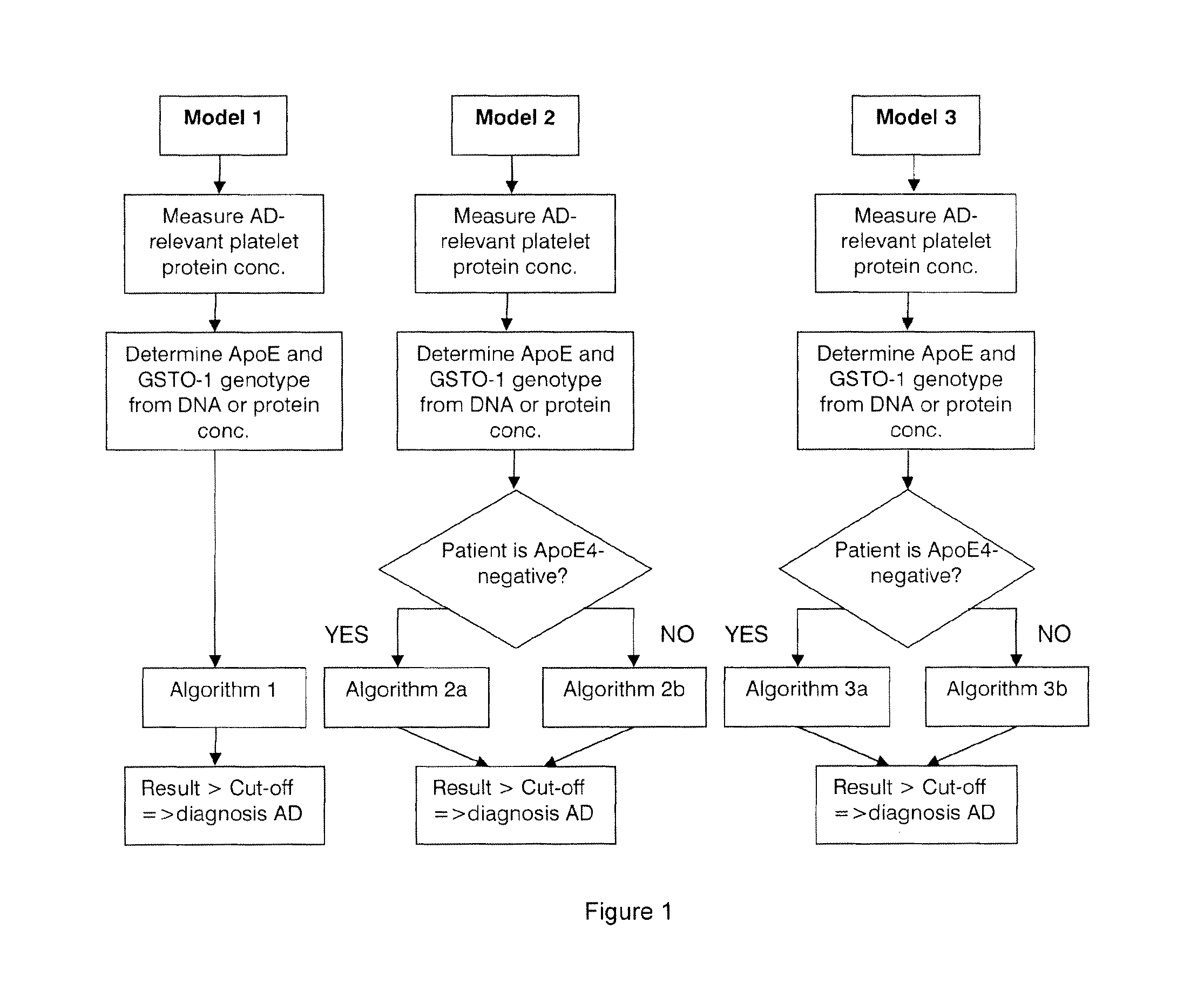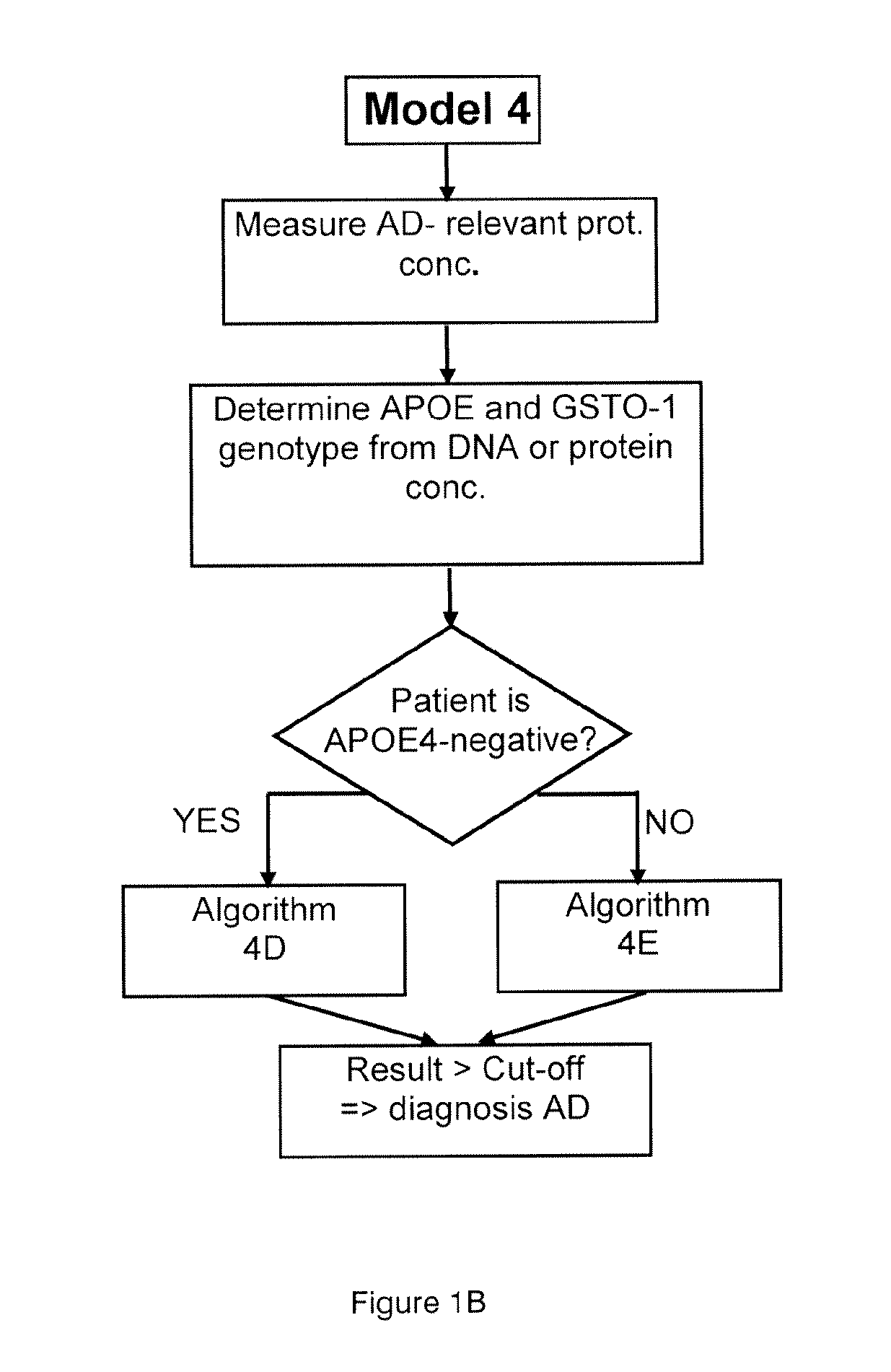Diagnostic method for Alzheimer's disease
a diagnostic method and alzheimer's disease technology, applied in the field of ex vivo diagnostic methods, can solve the problems of relatively small symptomatic benefits, collapse of neuronal transport system, presence of alzheimer's disease-characteristic neurological and neuropsychological features, etc., and achieve the effect of normalising biological variation in the expression level
- Summary
- Abstract
- Description
- Claims
- Application Information
AI Technical Summary
Benefits of technology
Problems solved by technology
Method used
Image
Examples
example 1
Analysis of Single Biomarker Assays and Assays Comprising Three, Four and Five Biomarkers for the Diagnosis of Alzheimer's Disease
[0104]Samples were collected in two phases and divided into a discovery set and validation set. The standard abundance of each platelet protein was measured using 2D-DIGE and ROC curves were generated in order to obtain optimal cut-off, actual cut-off, sensitivity and specificity values for each biomarker. The results for each of these single protein assays are shown in Table 5.
[0105]
TABLE 5ROCSingleSamplecurveOptimalActualSensitivitySpecificityAssaysetAUC95% CISignificancecut-offcut-off(%)(%)MAO-BDiscovery0.8470.714-0.9801.0721.0728980Validation0.8260.689-0.9641.0481.07275.180TotalDiscovery0.7970.655-0.9400.0021.8021.80283.365tropomyosinValidation0.7040.539-0.8690.0271.7481.80256.576.2CoagulationDiscovery0.7610.601-0.9210.0061.0361.0367865Factor XIIIaValidation0.7170.551-0.8830.0190.9291.03647.479ApoE4Discovery0.7970.647-0.9470.0020.50.56790Validation0.7...
example 2
Selection of 14-3-3 Gamma as an Internal Extraction Standard Protein
[0121]12.5 μg platelet protein from 24 Alzheimer's disease patients and 24 sex- and aged-matched controls was analysed in a 1D Western blot. The results are illustrated in FIG. 6 and show that the Mao-B signal is more intensive in platelet samples from Alzheimer's patients than control samples, whereas the intensity of the signal for 14-3-3 gamma is equal in all samples. As shown in FIG. 7, by measuring the Moa-B signal of 12.5 μg platelet protein without any normalisation only a low significant increase (P<0.01) can be detected in the Alzheimer's samples. After normalisation with 14-3-3 gamma however, the significance increases to P<0.00000007, which demonstrates that the precision with which a protein can be quantified in a sample increases enormously with the application of an internal extraction standard.
[0122]FIG. 8 shows a representative Western blot for the application of ERK2 as an internal extraction standa...
example 3
Verification of Alzheimer's Disease Polymorphism in GSTO-1
[0123]2D gel electrophoresis analysis revealed three GSTO-1 isoforms with pI values of 6.19, 5.87 and 5.64 (FIG. 9). These isoforms show distinct expression patterns in the three groups: AD patients, PD patients and age- and sex-matched controls. Gel-filtered platelet samples of non-ApoE Alzheimer's patients revealed significant up-regulation of the GSTO-1 isoform with pI 6.19 (increased by 35%), whereas the GSTO-1 isoform with pI 5.87 is down-regulated by 60%.
[0124]The results in FIG. 9 represent two mis-sense polymorphisms in exon 4 of GSTO-1 (Ala140Asp and Glu155A). The GSTO-1 spot with pI 6.19 corresponds to WT. The spot with pI 5.87 represents an isoform where Ala140 is substituted by Asp (Ala140Asp). The spot with pI 5.64 may relate to a post-translational modification of unknown origin. Equal expression of the GSTO-1 spots with pI 6.19 and pI 5.87 correspond to a WT isoform and an isoform comprising the Ala140Asp subst...
PUM
| Property | Measurement | Unit |
|---|---|---|
| hydrophobic | aaaaa | aaaaa |
| Gel Electrophoresis | aaaaa | aaaaa |
| concentration | aaaaa | aaaaa |
Abstract
Description
Claims
Application Information
 Login to View More
Login to View More - R&D
- Intellectual Property
- Life Sciences
- Materials
- Tech Scout
- Unparalleled Data Quality
- Higher Quality Content
- 60% Fewer Hallucinations
Browse by: Latest US Patents, China's latest patents, Technical Efficacy Thesaurus, Application Domain, Technology Topic, Popular Technical Reports.
© 2025 PatSnap. All rights reserved.Legal|Privacy policy|Modern Slavery Act Transparency Statement|Sitemap|About US| Contact US: help@patsnap.com



